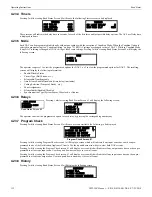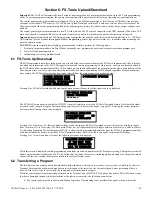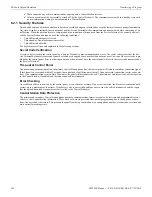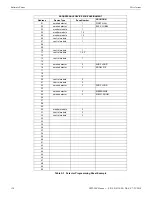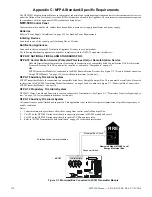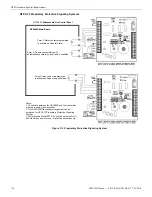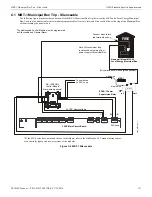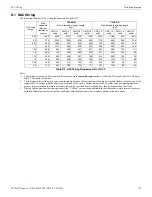
NFW-50X Manual —
P/N LS10129-001NF-E:C 7/25/2018
125
Section 9: Power Supply Calculations
9.1 Overview
This section contains instructions and tables for calculating power supply currents in alarm and standby conditions. This is a four-step
process, consisting of the following:
1.
Calculating the total amount of AC branch circuit current required to operate the system
2.
Calculating the worst-case system current load on the control panel, when primary (AC) power is applied, to assure that the limit of
the its internal power supply will not be exceeded. This considers the fire alarm condition only.
3.
Calculating the total current load on the batteries (secondary power source) in the event of an AC power loss. This considers both
standby and fire alarm conditions.
4.
Calculating the size of the batteries required to support the system if AC power loss occurs, based on the total battery current load,
plus a regulatory agency mandated derating factor.
9.2 Calculating the AC Branch Circuit
The control panel requires connection to a separate, dedicated AC branch circuit, which must be labeled
FIRE ALARM
. This branch
circuit must connect to the line side of the main power feed of the protected premises. No other non-fire alarm equipment may be pow-
ered from the fire alarm branch circuit. The branch circuit wire must run continuously, without any disconnect devices, from the power
source to the control panel. Overcurrent protection for this circuit must comply with Article 760 of the National Electrical Codes as well
as local codes. Use 14 AWG (2.00 mm
2
) wire with 600 volt insulation for this branch circuit.
Use Table 9.1, to determine the total amount of current, in AC amperes (A), that must be supplied to the system.
9.3 Calculating the System Current Load
9.3.1 Overview
The control panel’s internal power supply must support all connected devices while primary (AC) power is applied. The continuous sys-
tem current load is highest during a fire alarm condition. To calculate the fire alarm load on the internal power supply, use Calculation
Column 1 in Table 9.3 on page 126.
The secondary power source (batteries) must be able to power the system under both standby and fire alarm conditions upon loss of pri-
mary (AC) power. To calculate the fire alarm load on the secondary power source, use Calculation Column 2 in Table 9.3 on page 126.
To calculate the standby load on the secondary power source, use Calculation Column 3 in Table 9.3 on page 126.
All currents are given in amperes (A). Table 9.2 shows how to convert milliamperes and microamperes to full amperes.
9.3.2 How to Calculate System Current Load
Use Table 9.3 on page 126 to calculate current load as follows:
1.
Enter the quantity of devices in all three columns.
2.
Enter the current draw where required. Refer to the Device Compatibility Document and SWIFT Manual for compatible devices
and their current draw.
3.
Calculate the current draws for each in all columns.
4.
Sum the currents for each column. This is the total load.
5.
Verify that the total from Column 1 is less than or equal to the value specified in the note.
6.
Copy the totals from Column 2 and Column 3 to Table 9.4 on page 127.
Table 9.3 contains columns for calculating current load. For each column, calculate the current and enter the total (in amperes) in the bot-
tom row. When finished, copy the totals from Calculation Column 2 and Calculation Column 3 to Table 9.4 on page 127. For maximum
output current available per circuit and per panel, refer to Section 1.2, “Specifications”, on page 13.
Device Type
Number of
Devices
Current Draw
(AC amps)
Total Current per
Device
NFW-50X
1
X
1.75
=
CHG-75
[ ]
X
2.05
=
CHG-120
[ ]
X
2.00
=
[ ]
X
[ ]
=
Sum Column for AC Branch Current Required
=
Table 9.1 AC Branch Circuit Requirements
To convert...
Multiply
Example
Milliamperes (mA) to
amperes (A)
mA x 0.001
3 mA x 0.001 = 0.003A
Microamperes (µA) to
amperes (A)
µA x 0.000001
300 µA x 0.000001 = 0.0003 A
Table 9.2 Converting to Full Amperes


